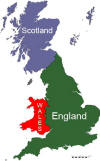Arthurian Legends
Once again, we're interested
in how these stories represent a mix of different sources and influences rubbing
up against each other to create an entirely new, fictitious, utopian vision of a
fantastic, ancient past.
Epic Legends
The Arthurian legends share the same qualities we've seen in other
epics, and like the
others they:
a) Were written by many authors over a period of hundreds of years.
Arthurian legends date back to the 600s in Britain, and Arthurian legends were
popular and written in Britain, France and Germany. The first complete
compilation of the legends was written by Mallory in 1485.
In the intervening 800 years, the legends vary
widely: in some, for example, Gawain is the most noble of all knights and in
others he's become a hyper-violent womanizer.
b) Perhaps have some shred of historical fact buried beneath many layers of
ancient oral myths. Likely, there was an important King named Arthur (see
below) whose life has absolutely nothing to do with the Arthurian legends.
c) Refer to beliefs and symbols so ancient that time has utterly obscured
their significance. While we still find these tales entertaining,
it's worth pondering that the authors might not have even known the once
historical or deeply religious significance of the described events and symbols
-- for 1400 years new cultures have retold these stories to suit their own
beliefs.
d) Indiscriminately blend the myths of otherwise competing cultures (i.e. mixing
Pagan/Druidic and Greek and Christian myths). See
the Holy Grail notes for an example.
Ancient Native Briton/Welsh Setting
The legends take place in Wales and the far Western (or Northern, up near Scottland)
reaches of “England”, where Roman-Briton culture was not over-run by Anglo
Saxons. The main characters are largely Welsh, and the actual stories are Welsh
and Celtic in pre-historic origin, which explains the emphasis on pagan-druidic
lore, monsters, dragons, magic etc – esp. in the Green Knight, Merlin, Morgan le
Faye (“Fairy”).

Roman Influence
Recall that the Romans occupied Britain for roughly 350 years, from 43-410
AD. They “civilized” the British Celts and Picts, and, as they’d done
throughout SW Europe and the Middle East, brought the rule of law, built great
theaters, roads, castles, walls and baths, and literature, and generally built
an empire that lingered in the Medieval mind as some sort of fantasty-ideal. They also
first brought Christianity (but only late in the occupation and with little
immediate, effect; the serious Christianizing of Britain happens a bit later), literacy, and Homer, Virgil and Ovid: the epic Greek and
Roman tales of heroism.
Arab and Persian
Influence
Americans usually forget that while Europe languished through the illiterate
Dark Ages, Arabic and Persian culture kept the Helenic/Greek culture of
literature and philosophy burning bright, and modeled after
Ovid, Greco-Roman style
"romances" were and still are popular in the Islamic era. These
spread into Europe during the 700 year long Moorish "occupation" of Iberia
(Spain and Portugal). You can read some of these in our anthology: look up
The Thousand And One Nights. We'll discuss this more as
Courtly Love.
King Arthur
The
earliest references to “Arthur” – or the king the monk Gildas calls “Ambrosius
Aurelianus” – is written around 547 and describes a “a most temperate man, who by chance
was the only person of Roman parentage to have come through the catastrophe in
which his parents, who had worn the royal purple toga, had been killed. … His
men challenged their previous conquerors [Anglo Saxon “Germans”] to battle, and
by the grace of God, victory was theirs” (The Romance of Arthur 4). See
Anglo Saxon Occupation Map
C.
800, the Welsh Nennius writes in his The History of the Britons that
“Then Arthur fought against these peoples (Anglo Saxon invaders) along with the
kings of the Britons, and he was the leader in their battles” (TRA 5).
To get
a good sense of how these legends took shape, consider that these first
references were written in Latin, probably written by monks, but that the source
of the legends is probably ancient Welsh myth.
Good
overview of the oldest origins of the myths:
http://www.wsu.edu/~delahoyd/medieval/arthurian.html
Medieval European Written Origin
The legends are set down in writing originally by 12th Century Medieval Briton,
Norman, "French" (Chretien
de Troyes c. 1150
Champagne France) and "German" authors. Recall that the Norman’s (N. France) invaded and occupied Britain in
1066. The chivalric ethical code, Christianity, feudal social/political order,
technology (warfare, castles) described by these (originally “French”
Norman/Brittany and German) authors represents their own time and place as much
as the mythologized utopian past.
